The Ultimate Guide to Winter Hiking: How to Choose a Safe Trail
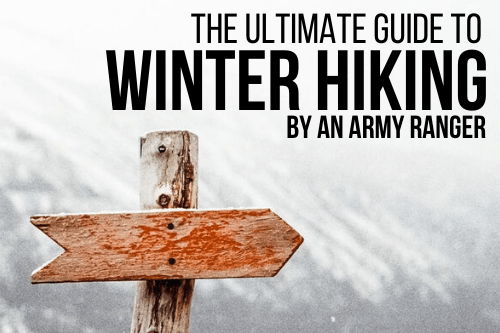

Written By Nathan Davy
missing hiking in the winter?
So you’ve read our guide: 10 More Essentials to Hike with a Baby and you are ready to try some winter hiking…
In Colorado, we have no shortage of ways to get outside and enjoy the great outdoors. But sometimes in the winter, when it hasn’t snowed for a few weeks, and we don’t feel like feel like skiing crusty groomers and rock hard moguls, we find ourselves sitting on our couches longing for those beautiful summer days hiking under bluebird skies.
We tend to think of hiking as an activity for late spring, summer, and early autumn when the aspen’s are changing colors. But when the first snow falls, most of us stow our trusty kid carriers and backpacks until the weather turns warm again.
the colorado hiking secret…
I’m going to let you in on a little secret, winter actually holds some of the best hiking Colorado has to offer. It can be done safely, and enjoyably with kids, but you’ll need to keep a few things in mind before you run out and hit the trails in the dead of winter with your Colorado Kid in tow:
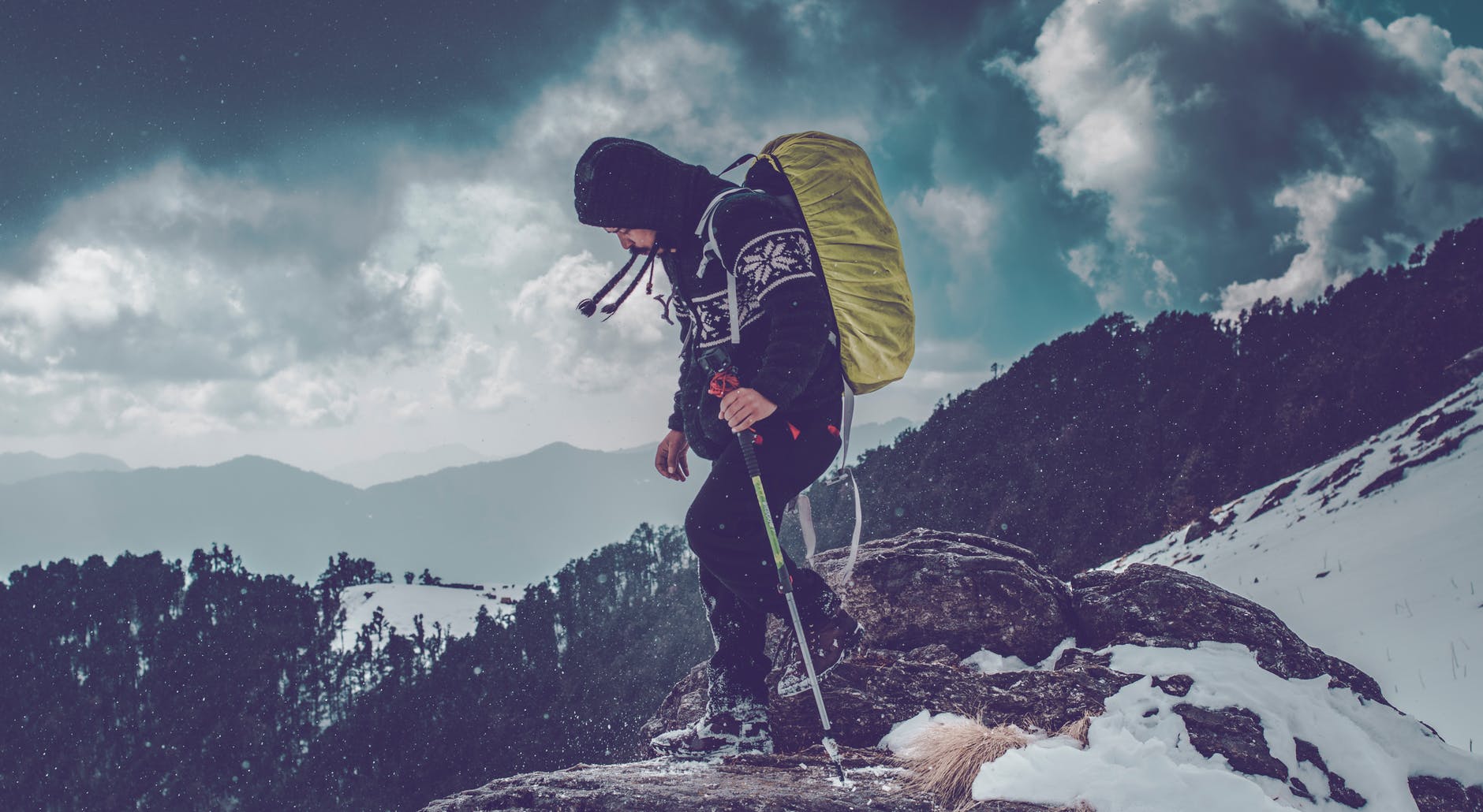
HOW TO CHOOSE A HIKE FOR WINTER: ACCESS
It is essential to choose the right hike for your family any time of the year. It’s even more critical when the mountains get their blanket of white, and temps dip below freezing. In winter, many forest roads leading to the best trail heads are not maintained and therefore covered in snow or ice, so it is essential to check that the road to the trailhead is well-maintained in the winter and preferably paved. Most county roads are well maintained, forest roads can go either way. It is always a good idea to call the local ranger district.
To determine which roads are paved or dirt checkout:
USDA Forest Service Interactive Map: https://apps.fs.usda.gov/TravelAccess/

3 TIPS FOR HOW TO CHOOSE A FAMILY FRIENDLY HIKE FOR WINTER

1. start with a small hike and build up to our big mountains
When you first start hiking in the winter, choose easier hikes than you would in the summer. Snow and ice on the trail can make steep terrain difficult for you and your children and cause more tears than instagram likes. Even a simple stroll through open space can feel like a great adventure for you and your kids when everything is covered in fresh snow glittering in the sun.
2. THE MOST POPULAR HIKES IN THE FOOTHILLS: ALL TO YOURSELF
Winter is the perfect time to enjoy many of the hikes in the foothills you often avoid in the summer due to heat, sun, and the inevitable crowds of tourists. Plus a fresh coat of snow on a familiar landscape can take it from beautiful and make it truly stunning. Explore this local hike for yourself the next time it snows: Flatiron’s Overlook Trail. It’s great for kids just old enough to hike on their own. Then try and tell me that the Flatirons, freshly frosted, aren’t worth getting the family out of the house to see.
Benefits of Hiking the Front Range in the Winter:
- No crowds compared to summer
- No snowpack means very little avalanche risk
- Warmer temperatures, dare I say warm? (don’t tell anyone)
- Short drive times make half-day excursions a reality
3. Remember safety first
As your appetite for winter hiking grows, you’ll probably want to venture further into the big mountains. Before you do, there are a few important safety factors to take into consideration when choosing a winter hike.
SOUTH VS. NORTH FACING SLOPES
It’s no secret that the north face of most North American mountains is the most difficult route to the summit, and with good reason, the Sun!
Often a south-facing slope can be snow free and feel warm in the sun, but when you round the ridge to a north facing slope, the sun might not rise above the ridgeline all winter long, you might find deep snow and feel ten or more degrees colder. Consider the angle of the slope when choosing your hike and plan accordingly.
Slope Angle Tool:
A great tool for assessing a trail’s south or north facing angle is www.CalTopo.com where you can look at the trail and see how it moves around the mountain. In the below example you can see one of our favorite local hikes in Golden, CO. The area highlighted in yellow faces south and is warm all winter long, where the area marked in red shows a east and north facing aspect of the mountain.
Want to learn more about this hike? You can read our full hike review here: North Table Mountain Climbers Route.
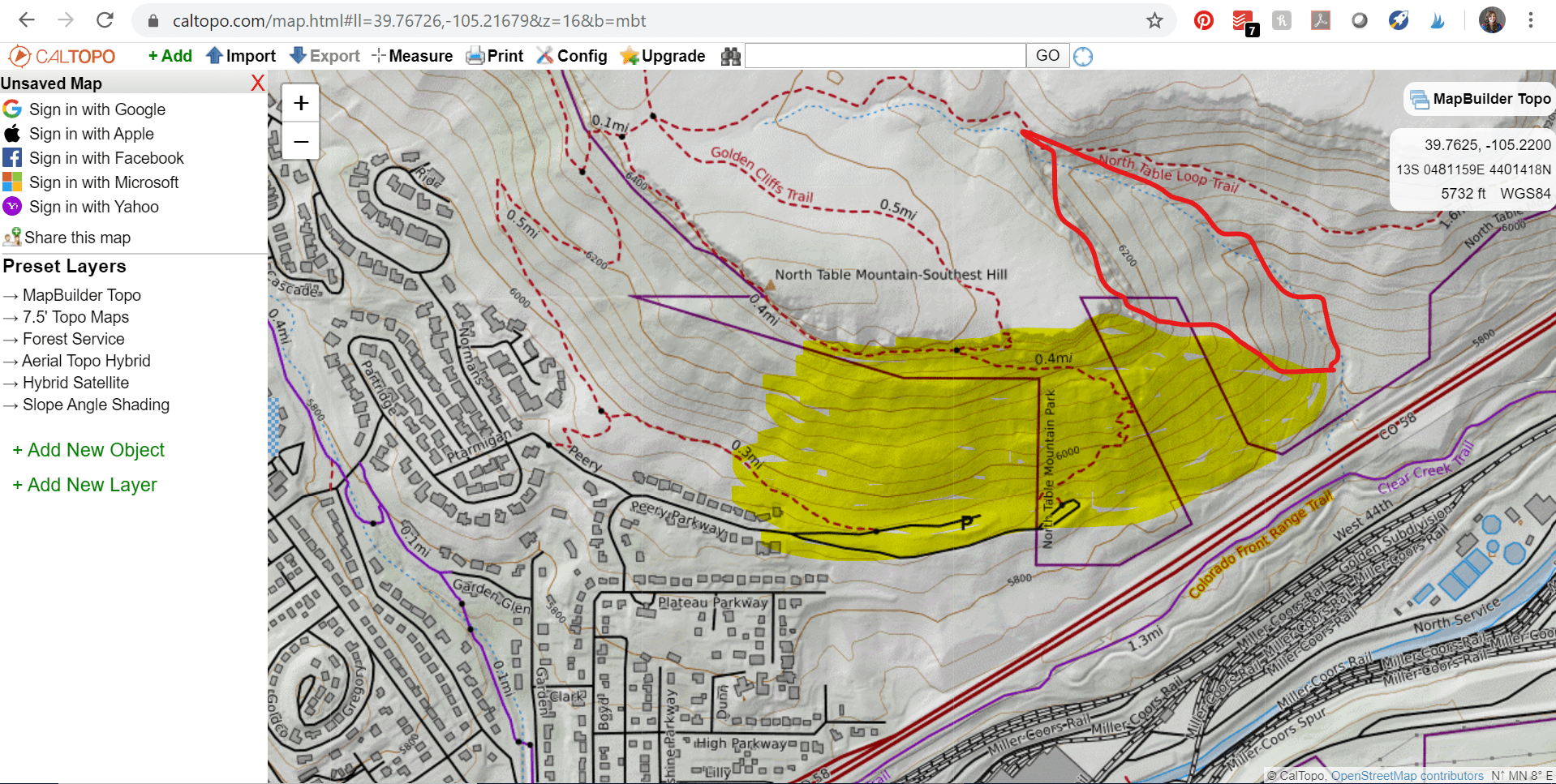
consider snowpack
If you choose an area that has had significant snowfall but no recent traffic, you might be knee deep or more in fresh snow. Amazing for skiing, sucks for hiking.
While it might be beautiful, I recommend choosing a hike that’s a little more popular such as Bear Lake in Rocky Mountain National Park. The more traveled hikes typically have a trail that is still easy to follow in the winter, and if there is enough traffic you might be able to get away without using snowshoes because the trail will be well packed. Conversely a seldom hiked trail could turn into a miserable slog even with snowshoes.
AVALANCHE RISK: IS WINTER HIKING EVEN SAFE?
Once the snow starts to fall in the foothills, forget about 14er’s, and other high alpine hikes. Some of Colorado’s best hikes in summer should not be considered in winter without significant avalanche equipment and training. These hikes will likely be frigid, exposed to high winds, and could present avalanche risk, even death. Not very family-friendly and my wife would not approve.
Still want to hike the Indian Peaks Wilderness or the Gore Range? Be safe and do your research. Hiking deep into our mountains can be perfectly safe, just make sure you know where you’re going. 99% of all avalanches occur on slopes between 30 and 45 degrees. I recommend looking at the hike you’re considering using www.Caltopo.com, a free mapping service with an option for slope angle shading. With this tool, you can be 100% sure that you’re not venturing into avalanche terrain with your child.
In the below example (same mountain as above), we can see that the terrain is shaded orange and red. See degree colors in the upper right of the screen that indicate slope angle. Red and Orange is NOT what you want to see for a winter hike. If North Table Mountain was covered with feet of snow, there would be a significant risk of avalanche.

To learn more about Avalanche Risk
- Visit Colorado Avalanche Information Center to get educated and view forecasts https://avalanche.state.co.us/
- Read Staying Alive in Avalanche Terrain
- Take an AIRIE Avalanche Safety Class https://coloradomountainschool.com/product-category/avalanche-training/
still considering a hike in the winter? check out our companion guides!
Got a suggestion?
Take these lessons and choose the absolute best hike for you and your family. Looking for suggestions on places to go? Checkout our Hike Reviews at www.ColoradoWithKids.com/Going-Out/
If you like this post, please share on social media it helps other families find us.

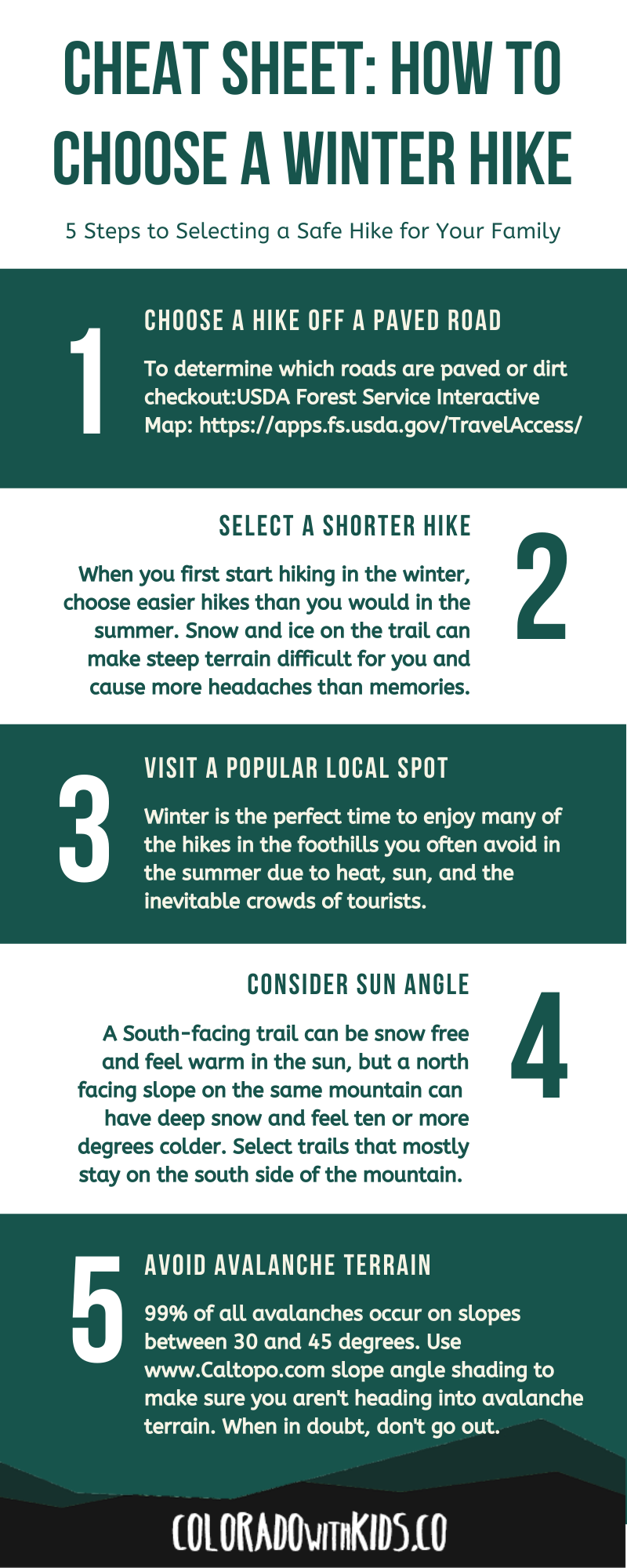
Related Articles
Related
27 Fun Kidtopia Keystone Resort Activities You Can’t Miss in 2020
Here are 27 Awesome Kidtopia Keystone Events Your Kids Can’t Miss this Summer or Winter! From Keystone’s Ultimate Snow Fort, to the best summer…
Travel Essentials: What to Pack for a (last-minute) Road Trip with Kids
We didn’t know we were driving 7 hours to Columbus, NE this weekend, but then we had to. Lessons Learned- Travel Essentials: What to Pack for a Road Trip with Kids.
10 Best Tips for Hiking in Winter: Hiking Outfits and Essential Gear
Top 10 Tips for Winter Hiking. What to wear, what essential gear to bring, when and where to go.

Get Out
Get out of the house and enjoy colorado with kids
Were a collaborative blog with a big mission to make it easy for you to enjoy Colorado with kids. Join the community to get weekly updates with our latest guides and tips.






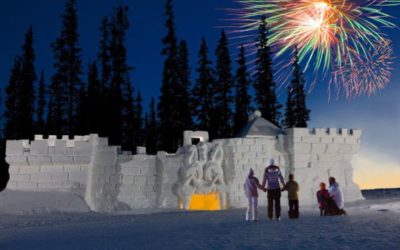



0 Comments